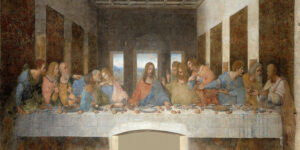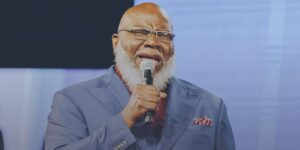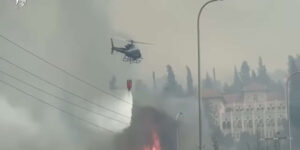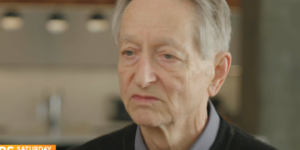Journey to the Holy Land: Meeting God on the Mountain
I thought we would retrace the footsteps of Moses to Mt. Sinai. Instead, God molded 14 men from all walks of life into a church and taught me lessons about myself.
Somehow it seemed impossible-retracing Moses’ footsteps in the desert in nine days when it took the children of Israel 40 years. When I was first invited to join a pilgrimage to the mountain of God, it seemed so remote, I could barely comprehend the fact I might actually go.
But I determined to go, despite the tough preparation that was necessary. I needed to shop for special equipment for the desert, spend weary miles jogging to get into shape, and read-including the first five books of the Bible.
Finally the day arrived. We assembled, 13 of us plus our leader at Kennedy Airport in New York.
But the nine days we were to spend in the desert had much more in store for us than retracing the footsteps of Moses. There in Kennedy Airport we prayed, men from all walks of life, many who had never met before, that God would mold us into a church. It was radical prayer, for none of us-especially me-knew exactly what it meant.
I learned later it meant we would have to commit ourselves to one another, to confront one another, and surely take personal inventory-for that is the essence of being a church. But none of us realized how quickly that prayer would be answered.
Jamie Buckingham, the author, was our group leader. This was his third trip to the Sinai, so we looked to him as our expert on what to do. He was going again to gather material for a book.
I’m not sure why I went. Maybe it was the romance of going to the Middle East; to a war zone; to an area steeped in history; to a place of my own religious roots, because it was on Mount Sinai that God gave Moses the Law.
I soon found out that we couldn’t actually retrace Moses’ footsteps. And it wasn’t because the wind blew them away, as a friend teased me before I left. I discovered that no one knows exactly the route taken by the children of Israel.
Nor does anyone know which peak is actually the mountain of God. The Mount Sinai was climbed-the one most Charismatics and Pentecostals accept-is called locally Jebel Musa, literally the “Mountain of Moses.”
Besides uncertainty about the route and the location of the mountain, we couldn’t retrace Moses’ footsteps starting in Egypt where he started because of the tense political situation between Israel (which had custody of the Sinai peninsula when we visited) and Egypt which had lost the Sinai in the Six-Day War of 1967, and which was preparing to get it back.
So we began our trip in Israel, entering the peninsula at modern-day Eilat (called Etzion-geber in the Old Testament), winding our way through magnificent mountains in a three-day trek by truck to the Gulf of Suez. Then, after stops to climb two mountains, we drove along the Gulf of Suez where we passed U.N., Egyptian, and Israeli guard stations’ and many relics of past wars strewed along the road.
Only when we reached the Gulf of Suez did we come close to following the route probably taken by the children of Israel. By then we had been in the desert several days. We were hot, tired and eager to get to our destination-Mount Sinai. Frankly, I could have cared less at that point about following Moses’ footsteps. The Lord was teaching me too much about relationships in the group and about myself to worry about Moses.
Our group consisted of four pastors, three writers, three doctors, two businessmen, one judge, one cowboy, two Americans living in Israel and two Israeli guides-18 in all. Except for the guides, all were fine Spirit-filled men, and we generally got along well. There was virtually no grumbling on the trip, and each man did his share of cooking and the necessary chores.
Soon, however, it became obvious each of us wasn’t as spiritual or perfect as we tried to project those first few days when each man put his best foot forward. After a day or two in the desert, our real selves began to show.
Yet, stuck for 1,400 miles on a huge six-wheel drive truck bouncing along through “wadis” (dry riverbeds) between mountains mostly on trails that couldn’t be called roads, miles from the nearest flush toilet or other semblances of civilization, we discovered something very quickly: we had to get along with the group. To leave the group would mean death in the desert. Literally.
But to stay in the group often meant death to oneself.
Jamie liked this. If you’ve read his books, you know he likes transparency. He encourages the people to let the dirt in their personalities come to the surface so that the Holy Spirit can clean it away. I think Jamie purposefully invited several of us to the desert because it would do us good.
The first few days were spent getting acquainted; getting accustomed to sleeping under the stars or drinking out of a canteen; getting used to the grime. Yet, it was-as Peter Marshall, a member of our group, put it-more than an exciting trip out with the boys. It was a time to meet God in a special way.
I needed that. I was spiritually hungry. As I reflected later, my spiritual mountaintops have come either at times of personal crisis when I’ve turned to God for help and cried out with all my heart. Or, they’ve come when there was a mighty move of the Holy Sprit usually accompanied by powerful preaching or teaching at a time when many others also met God in a powerful way.
Now here I was stuck in the Sinai desert, dirtier than I’d been since I was 10, having the time of my life, and except for the copious notes I took each night of the day’s activities, I had totally left my work back at the States.
I was more relaxed than I had been in years. I felt at peace. I was happy. I prayed and communed with God. But where was the spiritual experience I wanted?
The second day into the desert I shared this paradox with Jamie. “I feel I’m about to embark on something significant spiritually, but I don’t feel spiritual,” I said as we bounced along in the truck one day. “We’re all just having a good time.”
Unfortunately, during the first few days in the desert we barely took time to pray together and read the Bible in the morning-a fact that peeved one of the pastors who emerged as the shepherd of the Sinai flock.
Jamie, who never seems to worry about anything, told me not to worry. My inability to “feel spiritual” was normal.
“The Lord is letting things come to the surface,” Jamie said, “just wait.”
Sure enough. The next morning things began to surface. A few of the guys, including me, thousands of miles from wives and churches, began swapping stories they wouldn’t have told back home. Harmless stuff, really. But inappropriate for Spirit-filled Christians en route to the mountain of God.
Later, as we gathered for devotions on the sand, several of the men-including some who had entered into the joke-telling-expressed dismay, and offense over what had happened. Something was coming to the surface in my life that God wanted me to leave in the desert.
I quit telling racial or ethnic jokes years ago because I considered them in poor taste. Now I was cut to the quick because I realized God wanted me to abandon telling these other, inappropriate jokes, too.
No one condemned me specifically, but the Holy Spirit convicted me specifically. I didn’t say much that morning on the truck.
Interestingly, the tone of our trip took on more serious, less frivolous tone form that point. God was cleaning up our lives and bringing us together.
While I was grappling with what God was saying to me, a confrontation was brewing between two of the strongest-willed men on the trip: one a disciplined physician who is an expert on running and the other, one of the ministers on the trip.
Tension had been building on the trip because the minister was rather free in sharing his opinions about where some of us were spiritually-including me. I had already had my own small-scale confrontation with him, and had backed off. The desert, I concluded, was nowhere to confront a prophet.
The doctor, on the other hand, although easy-going in attitude, was intensely disciplined. Up each morning before the rest of us he would run eight to 10 miles later, however, some of us were worried. He had no canteen and we feared he had taken a wrong turn and was lost. All of us were relieved when we found him running south along the Gulf of Suez in Egyptian territory.
However, when he climbed in the truck (barely winded), the minister lit into him. What right did he have, the minister wanted to know, to leave the group in such a dangerous locale? In addition the minister thought running was an unhealthy obsession and he proceeded to tell him so in pointed terms.
The air was tense. We sensed a confrontation brewing.
That night around the campfire, several of the men told the minister he had lacked tact on the truck. That led to a rehash of what had happened. The doctor apologized for scaring everyone, but said that his running had merely become a part of his lifestyle; it wasn’t an obsession.
Then, in a straightforward manner, he turned to the minister and sharply pointed out his problems. Especially did he hone in on the man’s critical attitude-a problem several of us had sensed. The minister reacted strongly.
None of us moved lest we be drawn into the crossfire.
Finally, one of the men told the minister that he had no right to dish out criticism unless he could take it also. Yet he had just reacted in a way he had said it was wrong for others to react.
The confrontation between the two was a watershed for our trip. First, the minister was much more subdued during the rest of our time in the desert. The doctor was more careful to stay with the group. And, the fact the group had participated in that open confrontation brought everyone closer.
Instead of being just a group of American men on a trip to the desert, we were becoming a body of believers-a church-learning to live together as we each moved toward God on the Mount.
Yet one of our greatest lessons in becoming a church was yet to come.
Our first climb was to the summit of Seribit el Khadhim in northwest Sinai. On top was an Egyptian temple complete with hieroglyphics and a sphinx. Nearby were abandoned turquoise mines worked three millennia ago by Israeli slaves. Inside those mines are the first examples of our alphabet-call proto-sinaitic writing. (I told my journalist friends later that was a holy place for us writers.) The descent was quite steep and often took my breath away. And, I do not ordinarily fear heights.
But one man on our trip did fear heights. Dick Love, a pastor from Fort Lauderdale, Florida, had such a severe acrophobia that he could not walk alone along a ledge six feet off the ground. Why, I asked myself, did he join a mountain-climbing pilgrimage?
We had prayed for healing for Dick’s acrophobia in Jerusalem before coming to the desert. But when we climbed Seribit, he stayed behind. He wasn’t healed.
Several the men discussed Dick’s problem as we climbed. They felt sorry for Dick because of the self-condemnation he must be feeling. Waiting far below as we climbed.
On top of Seribit, in front of the Egyptian temple, we stopped for devotions.
Each of us prayed. I felt my prayers didn’t sound “spiritual enough.” Yet I kept feeling that God was trying to teach me that being very spiritual to being very natural. So why this conflict inside?
When it was Jamie’s turn to pray, his prayer was the least ostentatious of all, but it was the one worth writing down in the tiny spiral memo pad I carried with me at all times.
First he prayed for Dick Love down in the valley. Then, he said, “Father, thanks for the mountaintop experiences, but keep us in the valley until we’re ready for more of these experiences.
“Help us to remember that we’re a body, and we can go no faster than the slowest member, just as the Israelites were slowed by the slowest one.”
John Sherrill, the best-selling author, particularly empathized with Dick Love’s problem because John had a minor fear of heights. At several steep places in the climb he had to inch his way along. The steep descent down the far side of the mountain was difficult for John until our Israeli guide took his hand and led him over the scarier ledges. He told us later that the touch of a human hand gave him a confidence he lacked as he climbed.
On the climb down I noticed a sort of camaraderie developing among us, I had not seen before. One of the men, a circuit court judge from South Carolina, had one leg badly damaged from childhood polio. He could climb with the best, but it was slow going for him. Some of the men purposely stayed with him so he wouldn’t fall too far behind the group.
The next morning we were to climb Mount Tahuneh, the place where Aaron and Hur held up the hands of Moses during the battle of the Amalakites. Several of the men encouraged Dick to make the climb. They pledged to help him.
The mountain towers 750 feet above the valley (about as high as a 75-story building) over the Valley Rephidim.
We had prayed again for Dick to be healed of his fear of heights. Then two men told him they would “walk through” his healing with him.
What happened next was the most incredible example of “laying on hands” I’ve ever seen. Stan Elrod, a contractor from Charlotte, N.C., and the group’s comedian, took hold of Dick’s belt in the back. Dr. Jim Gills, an ophthalmologist from New Port Richey, Florida, grabbed Dick’s hand. They led that grappling six-foot-plus tall man up the mountain as you’d lead a blind man.
Dick clung to the side of the mountain and he refused to look down as he climbed inch by agonizing inch. Meanwhile, the helps coaxed, prayed for, and held on to Dick each step of the way.
At the top of the mountain is a magnificent view of the Valley Rephidim and a palm-filled oasis in the center of the valley. No wonder Moses climbed this mountain to view the battle. He could see for miles.
The remnants of a centuries’ old chapel, left from monks who lived there a thousand years ago, sits at the top of Tahuneh. It was a perfect setting for a victory celebration. When Dick Love and his entourage reached the summit, we applauded. “The victory’s been won,” someone shouted.
Dick told us that as he came up the mountain, he began to lose his fear of heights. He said that at one time he would have fainted just looking at the view from the top of Tahuneh. Now, he rather enjoyed the beauty. In addition, he appreciated the fact we not only told him what to do, but we walked up the mountain with him.
Dick went down the mountain much easier than he came up, although the same men “laid hands on him” all the way down. The next day we climbed Mount Sinai-a much more difficult and much longer climb-Dick did most of it by himself.
Before we posed for photos with each of us holding up our arms like Moses, supported by two other men, an Atlanta pastor asked us to judge something he felt in his spirit.
He said he had a spiritual feeling that the mountain of the Ten Commandments was really not Mount Sinai, as accepted by most scholars (the one we’d climb tomorrow) but rather it was nearby Jebel Serbal.
All this sounded a bit “super-natural” to most of us in our “church.” Yet, several complimented him on being so sensitive to the spirit.
Finally, Jamie Buckingham gave his opinion and summed up the essence of our trip to the desert:
“Places are important to history and geologists,” Jamie said. “But they aren’t important to spiritual things.
“We all have our own mountaintop experiences. We carry out Sinais inside us. We don’t have to climb the literal mountain. It’s what we carry in our hearts that is more important than where we are.”
Each night we made camp about 5 or 6 and usually were in bed by 8. Several nights I took my sleeping bag a quarter-mile away from the group. Since there were no animals, almost no reptiles or bugs, and fewer people, I felt safe. I wanted to experience “silence.”
There is no silence like the silence of the desert. When the wind isn’t blowing, there is absolutely no sound. It was so quiet I could hear the bones in my neck rub together as I turned my head. I had never before experienced a total absence of sound.
It was awesome to lie in a sleeping bag, stare at the stars and realize that in this desert there is only God and me.
In my sleeping bag at night I was totally separated from the religious trappings and spiritual crutches in my life. It caused me to be honest in a way I’m not usually honest with the Lord.
So at night as I prayed I confessed my fears, my faults, my insecurities, and my pride. I told God things He already knew. But alone in the desert, there was a release being able to blurt out everything-out loud so I could hear it too.
I also prayed over some needs that awaited me when I returned home. As I enumerated each need, the Lord began to speak to my heart, reminding me that meeting my needs is nothing to Him. Meeting my needs is certainly easier (naturally speaking) than the way He fed the Israelites and cared for them in the desert. Wouldn’t He care for me?
I knew that I knew that I knew He would.
In the desert we also learned some things about caring for each other’s infirmities. Three of the men ate something that gave them what we called “pharaoh’s revenge.” Fortunately, the sickness lasted only 24 hours, but we had to care for them in the meantime. That, too, was a part of becoming a church in the desert.
Then, Dick Bolen, one of the pastors, stepped on an acacia thorn that pierced the inch-thick soles of his hiking boots and embedded itself in his foot. The injury caused his foot to swell and I did not expect Dick to climb the mountain. But Dick made it to the top through sheer tenacity despite excruciating pain.
We reached a plain at the backside of Mount Sinai (Jebel Musa) on our sixth day in the desert and made camp. We were 5,000 feet up, and it was bitterly cold.
When we rose at 3 a.m. to begin our ascent, the temperature hovered slightly above freezing. I wore socks on my hands to help keep warm.
We started the climb together, but soon the group thinned out, each man climbing at his own pace. I was glad. I wanted to be alone. I was finally climbing the mountain of God, and I had a few things to petition of my Father.
I had decided to specifically call before the Lord the names of all my relatives, business associates and friends, asking Him to bless them. Occasionally, I prayed quietly in the Spirit, because English could not express the prayer in my heart.
The climb became steeper, and I came to rough rocky steps built centuries before by a monk who devoted his life to the 30-year task of forming the 3,000 steps to the summit out of the sandstone boulders littering the side of the mountain. It was his way to work his way to heaven.
The sun poked over the surrounding mountains while I was half way up Mount Sinai. I stopped to marvel at the sight, wishing I could preserve its memory forever, and realizing that Moses may have watched the sun rise over the same mountains many times.
I reached the summit about seven. Several of the men were already there, sitting in various crevices, praying or meditating. On top is a small abandon stone chapel and next to it a boulder. I climbed atop the bolder, the peak of the mountain, and sat there in the early-morning sun for 45 minutes.
I read the account of Moses on Mount Sinai in the paperback Bible I brought with me, then stared at mountains in every direction. I had already been praying several hours. My heart and mind were primed for what was beginning to happen in my heart.
I began to experience an overpowering sense of the presence of God. I felt God’s omnipotence, His power, His love for me. I knew I was at peace with God. I knew He had brought me to this point, not only to this mountain, but also to the point in my walk with Him. I began to weep-something that I rarely do. But my tears weren’t tears of sorrow. They were because I couldn’t handle emotionally what I was sensing.
I began to write down in my ever-present memo pad some of the things I felt-especially some thoughts I believed God was whispering to my heart.
“I love you, Steve, and I’m trying and perfecting you,” this Still Small Voice said. “I want you to live a sinless life…I heard your prayer and I will answer, wait and see for I am God…”
Then, I decided to write down my own covenant with God. Not that I needed to make a new covenant-Jesus had done that. But I wanted to reaffirm in some tangible way that I belong to God-100 percent.
“Today I make a covenant with God,” I wrote. “I will serve You and follow You steadfastly. I will love You as never before. I will to live a sinless life by the power of your Holy Spirit. I will be the prophet and priest of my home. I will raise my son to serve You. I will strive to follow Your Word and to do Your will as I understand it…” There was more too personal to share.
Then, I wrote, “I ask that You will do new things in my life as a result of this covenant…” I signed my name and dated it.
I noticed the other men were gathering to have prayer and share communion. I left my perch on the top of the boulder to join them on an adjacent boulder.
I knew that I’d never be the same. I’d been on a mountaintop with God. And it wasn’t just because I had been on the top of Mount Sinai.





































